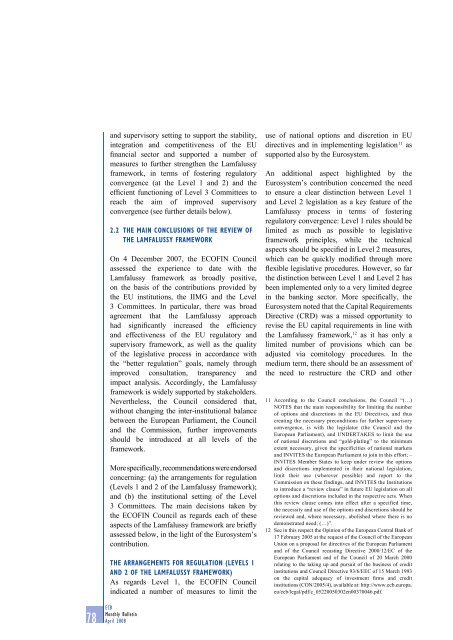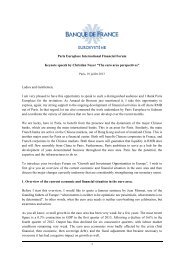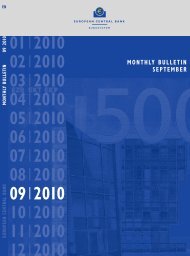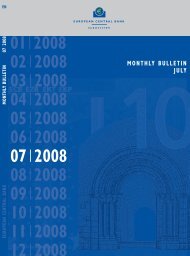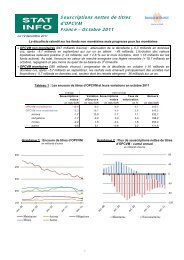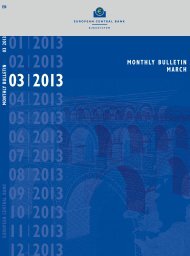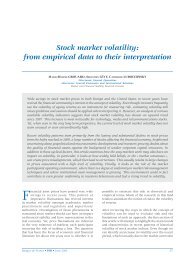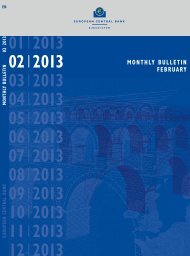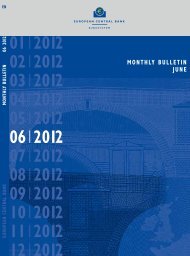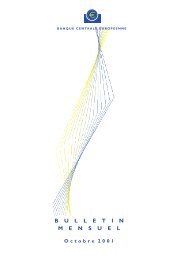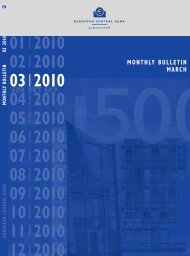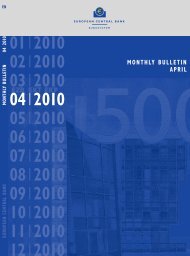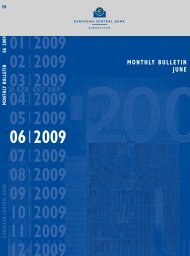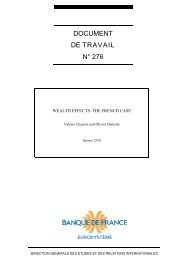Monthly Bulletin April 2008 - European Central Bank - Europa
Monthly Bulletin April 2008 - European Central Bank - Europa
Monthly Bulletin April 2008 - European Central Bank - Europa
You also want an ePaper? Increase the reach of your titles
YUMPU automatically turns print PDFs into web optimized ePapers that Google loves.
and supervisory setting to support the stability,<br />
integration and competitiveness of the EU<br />
financial sector and supported a number of<br />
measures to further strengthen the Lamfalussy<br />
framework, in terms of fostering regulatory<br />
convergence (at the Level 1 and 2) and the<br />
efficient functioning of Level 3 Committees to<br />
reach the aim of improved supervisory<br />
convergence (see further details below).<br />
2.2 THE MAIN CONCLUSIONS OF THE REVIEW OF<br />
THE LAMFALUSSY FRAMEWORK<br />
On 4 December 2007, the ECOFIN Council<br />
assessed the experience to date with the<br />
Lamfalussy framework as broadly positive,<br />
on the basis of the contributions provided by<br />
the EU institutions, the IIMG and the Level<br />
3 Committees. In particular, there was broad<br />
agreement that the Lamfalussy approach<br />
had significantly increased the efficiency<br />
and effectiveness of the EU regulatory and<br />
supervisory framework, as well as the quality<br />
of the legislative process in accordance with<br />
the “better regulation” goals, namely through<br />
improved consultation, transparency and<br />
impact analysis. Accordingly, the Lamfalussy<br />
framework is widely supported by stakeholders.<br />
Nevertheless, the Council considered that,<br />
without changing the inter-institutional balance<br />
between the <strong>European</strong> Parliament, the Council<br />
and the Commission, further improvements<br />
should be introduced at all levels of the<br />
framework.<br />
More specifically, recommendations were endorsed<br />
concerning: (a) the arrangements for regulation<br />
(Levels 1 and 2 of the Lamfalussy framework);<br />
and (b) the institutional setting of the Level<br />
3 Committees. The main decisions taken by<br />
the ECOFIN Council as regards each of these<br />
aspects of the Lamfalussy framework are briefly<br />
assessed below, in the light of the Eurosystem’s<br />
contribution.<br />
THE ARRANGEMENTS FOR REGULATION (LEVELS 1<br />
AND 2 OF THE LAMFALUSSY FRAMEWORK)<br />
As regards Level 1, the ECOFIN Council<br />
indicated a number of measures to limit the<br />
use of national options and discretion in EU<br />
directives and in implementing legislation 11 as<br />
supported also by the Eurosystem.<br />
An additional aspect highlighted by the<br />
Eurosystem’s contribution concerned the need<br />
to ensure a clear distinction between Level 1<br />
and Level 2 legislation as a key feature of the<br />
Lamfalussy process in terms of fostering<br />
regulatory convergence: Level 1 rules should be<br />
limited as much as possible to legislative<br />
framework principles, while the technical<br />
aspects should be specified in Level 2 measures,<br />
which can be quickly modified through more<br />
flexible legislative procedures. However, so far<br />
the distinction between Level 1 and Level 2 has<br />
been implemented only to a very limited degree<br />
in the banking sector. More specifically, the<br />
Eurosystem noted that the Capital Requirements<br />
Directive (CRD) was a missed opportunity to<br />
revise the EU capital requirements in line with<br />
the Lamfalussy framework, 12 as it has only a<br />
limited number of provisions which can be<br />
adjusted via comitology procedures. In the<br />
medium term, there should be an assessment of<br />
the need to restructure the CRD and other<br />
11 According to the Council conclusions, the Council “(…)<br />
NOTES that the main responsibility for limiting the number<br />
of options and discretions in the EU Directives, and thus<br />
creating the necessary preconditions for further supervisory<br />
convergence, is with the legislator (the Council and the<br />
<strong>European</strong> Parliament), and UNDERTAKES to limit the use<br />
of national discretions and “gold-plating” to the minimum<br />
extent necessary, given the specificities of national markets<br />
and INVITES the <strong>European</strong> Parliament to join in this effort; –<br />
INVITES Member States to keep under review the options<br />
and discretions implemented in their national legislation,<br />
limit their use (wherever possible) and report to the<br />
Commission on these findings, and INVITES the Institutions<br />
to introduce a “review clause” in future EU legislation on all<br />
options and discretions included in the respective acts. When<br />
this review clause comes into effect after a specified time,<br />
the necessity and use of the options and discretions should be<br />
reviewed and, where necessary, abolished where there is no<br />
demonstrated need; (…)”.<br />
12 See in this respect the Opinion of the <strong>European</strong> <strong>Central</strong> <strong>Bank</strong> of<br />
17 February 2005 at the request of the Council of the <strong>European</strong><br />
Union on a proposal for directives of the <strong>European</strong> Parliament<br />
and of the Council recasting Directive 2000/12/EC of the<br />
<strong>European</strong> Parliament and of the Council of 20 March 2000<br />
relating to the taking up and pursuit of the business of credit<br />
institutions and Council Directive 93/6/EEC of 15 March 1993<br />
on the capital adequacy of investment firms and credit<br />
institutions (CON/2005/4), available at: http://www.ecb.europa.<br />
eu/ecb/legal/pdf/c_05220050302en00370046.pdf.<br />
78 ECB<br />
<strong>Monthly</strong> <strong>Bulletin</strong><br />
<strong>April</strong> <strong>2008</strong>


